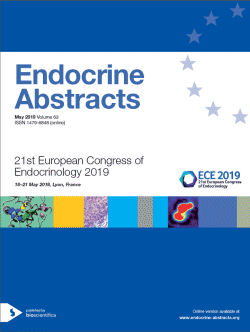
21st European Congress of Endocrinology
Lyon,
France
18 May 2019 - 21 May 2019
Guided Posters
Anterior and Posterior Pituitary
ea0063gp233 | Anterior and Posterior Pituitary | ECE2019
Evaluation of postoperative copeptin concentration as a predictive factor of diabetes insipidus after pituitary surgery. preliminary results
Navarro-Hoyas C , Gotarredona J Serrano , Delegido-Gomez L , Alfayate R , Serrano Corredor S , Revert Marrahi P , Sanchez-Ortiga R , Alfonso A Pico
ea0063gp234 | Anterior and Posterior Pituitary | ECE2019
Is the molecular study of pituitary transcription factors useful in the identification of Pituitary Neuroendocrine Tumor subtypes according to the new WHO 2017 criteria?
Garcia-Martinez Araceli , Martinez-Lopez Sebastian , Torregrosa Maria Eugenia , Silva Sandra , Fajardo Carmen , Camara Rosa , Lamas Cristina , Aranda Ignacio , Pico Antonio
ea0063gp235 | Anterior and Posterior Pituitary | ECE2019
The effect of previous optic chiasm compression on the post-illumination pupil response in pituitary patients
Boertien Tessel , Meijden Wisse van der , Coumou Adriaan , Drent Madeleine , Someren Eus Van , Romijn Hans , Fliers Eric , Bisschop Peter
ea0063gp236 | Anterior and Posterior Pituitary | ECE2019
Characteristics and natural history of a large cohort of non-functioning pituitary incidentalomas: a two-centers study
Betella Nazarena , Tresoldi Alberto , Carosi Giulia , Sindaco Giulia Del , Locatelli Marco , Mazziotti Gherardo , Milani Davide , Morenghi Elena , Spada Anna , Arosio Maura , Mantovani Giovanna , Lania Andrea
ea0063gp237 | Anterior and Posterior Pituitary | ECE2019
Diagnostic accuracy of copeptin in the diagnosis of diabetes insipidus after pituitary surgery
Ferrante Emanuele , Serban Andreea , Sala Elisa , Cremaschi Arianna , Grassi Giorgia , Locatelli Marco , Arosio Maura , Mantovani Giovanna
ea0063gp238 | Anterior and Posterior Pituitary | ECE2019
Immune checkpoint inhibitors therapy-induced hypophysitis is frequently associated with previous thyroid disorders: results from ImmuCare study
Levy Manon , Abeillon Juliette , Borson-Chazot Francoise , Dalle Stephane , Raverot Gerald , Cugnet-Anceau Christine
ea0063gp239 | Anterior and Posterior Pituitary | ECE2019
Peptide receptor radionuclide therapy (PRRT) in patients with giant aggressive pituitary tumors: experience of an Italian referral center and review of literature
Giuffrida Giuseppe , Ferrau Francesco , Laudicella Riccardo , Cotta Oana Ruxandra , Vento Antonio , Baldari Sergio , Cannavo Salvatore
ea0063gp240 | Anterior and Posterior Pituitary | ECE2019
Adrenal axis deterioration in the families/sporadic patients with PROP1 mutation, over 30 years of single center longitudinal observation
Gilis-Januszewska Aleksandra , Rogoziński Damian , Kluczyński Łukasz , Zygmunt-Gorska Agata , Wojcik Małgorzata , Starzyk Jerzy , Hubalewska-Dydejczyk Alicja
ea0063gp241 | Anterior and Posterior Pituitary | ECE2019
Inflammatory response to osmotic stimulus in healthy volunteers
Sailer Clara O , Wiedemann Sophia , Fenske Wiebke K , Schnyder Ingeborg , Strauss Konrad , Christ-Crain Mirjam
ea0063gp242 | Anterior and Posterior Pituitary | ECE2019
Copeptin levels in SIADH – a marker of malignant disease?
Winzeler Bettina , Steinmetz Michelle , Refardt Julie , Cesana-Nigro Nicole , Popovic Milica , Fenske Wiebke , Christ-Crain Mirjam
ea0063gp243 | Anterior and Posterior Pituitary | ECE2019
Histological classification of pituitary neuroendocrine tumors: genomic insights on cell lineage
Villa Chiara , Neou Mario , Armignacco Roberta , Jouinot Anne , Septier Amandine , Perlemoine Karine , Bernier Michele , Laure Raffin-Sanson Marie , Baussart Bertrand , Bertherat Jerome , Gaillard Stephan , Assie Guillaume
ea0063gp244 | Anterior and Posterior Pituitary | ECE2019
Tomosyn negatively regulates arginine vasopressin secretion in embryonic stem cell-derived neurons
Sugimura Yoshihisa , Takeuchi Seiji , Watanabe Takashi , Kiyota Atsushi , Fujisawa Haruki , Seino Yusuke , Suzuki Atsushi



